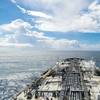USCG Issues Policy Letter
Subj: ALTERNATE PRESSURE RELIEF VALVE SETTINGS ON VESSELS CARRYING LIQUEFIED GASES IN BULK IN INDEPENDENT TYPE B AND TYPE C TANKS.
Ref:
(a) International Code for the Construction and Equipment of Ships Carrying Liquefied
Gases in Bulk, 1993 Edition (IGC Code)
(b) Title 46 Code of Federal Regulations (CFR) Part 54
(c) Title 46 Code of Federal Regulations (CFR) Part 154
(d) American Society of Mechanical Engineers (AMSE) Boiler and Pressure Vessel
Code (BPVC) Section VIII
1. PURPOSE. To provide policy for alternate pressure relief valve settings for ships carrying liquefied gases in bulk in independent type B and type C tanks.
2. ACTION. USCG Headquarters Units and Offices and Districts and Sector Commanders shall use the guidance in this policy letter to ensure compliance with U.S. statutory and regulatory requirements.
3. DIRECTIVES AFFECTED. This policy will be reflected in a subsequent regulatory update to applicable U.S. regulations.
4. BACKGROUND. The IGC Code, reference (a), specifies lower stress factors for Type B and Type C tanks than the requirements in references (b) and (c). As a result, all ships carrying liquefied gases in bulk entering the navigable waters of the United States must use lower maximum allowable relief valve settings (MARVS) on Type B and C tanks than required by the IGC Code. Therefore vessels operating in US and international waters opt to have two pressure relief valve (PRV) settings per tank which must be switched upon entering and exiting U.S. territorial waters.
5. DISCUSSION.
a. When references (b) and (c) were written, the stress factors were influenced by the requirements of reference (d) at the time. ASME has since lowered the stress factors.
b. According to 46 CFR 154.32, vessels may meet an alternative standard if the Commandant determines that the alternate standard provides an equivalent or greater level of safety. Materials, manufacturing, and inspection have advanced since the current regulations were written, and tanks designed and manufactured with these more advanced techniques and with the stress factors in the IGC Code have an equivalent level safety to the current regulations. Therefore tanks manufactured under certain conditions are considered to meet the level of safety required in 46 CFR 154.447 and 46 CFR 154.450.
6. PROCEDURES.
a. Tanks meeting the following two requirements may use MARVS specified in reference (a):
1. They must be designed and built according to the 1993 edition of the IGC code, including all amendments through 1 October 1994.
2. They must be on a vessel having an International Certificate of Fitness for the Carriage of Liquefied Gases in Bulk issued by a U.S. Coast Guard Recognized Classification Society authorized to issue such a certificate. (See 46 CFR part 8, subpart B). A current listing of U.S. Coast Guard Recognized Classification Societies is available at http://www.uscg.mil/hq/cg5/acp/.
b. Tanks that do not meet these requirements must meet current U.S. regulations. See references (b) and (c). Alternately, shipowners may request equivalencies to use the MARVS as determined from the IGC Code. Requests for equivalencies should be directed to the U.S. Coast Guard Commandant (CG-ENG-5) and must include the information required in 46 CFR 154.32(b) and should include a copy of the Certificate of Fitness.
7. DISCLAIMER. This policy is not a substitute for applicable legal requirements, nor is in itself a regulation. It is not intended to nor does it impose legally-binding requirements on any party. It represents the Coast Guard’s current thinking on this topic and may assist industry, mariners, the general public, and the Coast Guard, as well as other federal and state regulators, in applying U.S. statutory and regulatory requirements.
8. QUESTIONS. Questions or concerns regarding this policy may be directed to Commandant (CG-ENG-5) at (202) 372-1412 or emailed to [email protected].














